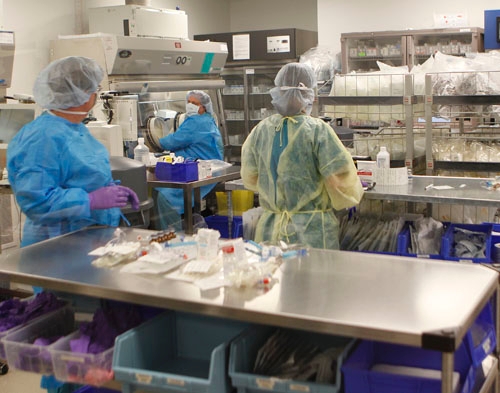Hospitals adapt to drug shortages


This is not your Walgreens or CVS pharmacy.
To enter the room at University Medical Center where the drugs are mixed that will be placed in a patient’s IV, pharmacists and pharmacy technicians wear gowns and face masks and gloves and shoe coverings.
Pictures are taken from overhead as the lifesaving concoctions are finalized by technicians, monitored outside on screens by senior pharmacists.
“You have to have a sterile environment and ensure safety here,” Diana Bond, director of pharmaceutical services at the hospital, said Wednesday. “Remember, these are drugs that will be injected inside a patient.”
But even the state-of-the-art pharmaceutical operation at UMC, and those at hospitals throughout the Las Vegas Valley and the United States, face a growing problem with the shortage of medications, a problem that could put lives at risk.
A scarcity of more than 200 medications, caused largely by fewer manufacturers wanting to produce less profitable generics, means hospitals must often rush to find substitute or alternative drugs so that patients can get the treatment they need.
“I’m worried that one day I’ll need a certain drug to save a patient’s life and we won’t have it,” said Dr. Dale Carrison, head of emergency at UMC and the hospital’s chief of staff. “This has been going on for some time now, but it is a problem that is snowballing.”
So far, no local hospital has reported patient harm because of the shortage of medications, which can range from morphine for pain to cytarabine, a chemotherapy drug used for leukemia.
Bond said her unit has had to notify medical staff on occasion that substitute drugs must be used to ensure that patients got treated.
Jason Glick, director of the pharmacy for the three St. Rose Dominican Hospitals, said his staff spends an extra two hours a day calling wholesalers and manufacturers for “short supply meds,” activity which he said “so far” has kept St. Rose from having to use alternative medications.
The problem is so serious in the country, Glick said, that some drug manufacturers have to keep some health care organizations from “hoarding” medications.
The Valley Health System of hospitals — Centennial Hills, Desert Springs, Spring Valley, Summerlin and Valley — “communicate what shortages are occurring and what the correct substitutions/alternatives are for medications,” said Gretchen Papez, a Valley spokeswoman.
Dan Davidson, a vice president of Sunrise Health System, said Sunrise, MountainView and Southern Hills hospitals are fortunate to be part of the HCA national chain, which has more than 170 hospitals.
Not only can they share medications within Las Vegas, he said, but they can do so with hospitals around the country.
“Pharmacists and physicians may discuss medication alternatives when necessary to meet the clinical needs of a patient,” Davidson said.
Erin Fox, a pharmacist with the University of Utah’s Drug Information Service, which tracks the shortage of drugs for the American Society of Health System Pharmacists, said all hospitals are affected by the medication shortage.
The situation could get deadly.
“We’re almost at the tipping point,” Fox said, adding that chemotherapy has had to be postponed for some patients around the country.
Last fall, the Institute for Safe Medication Practices reported that two patients died from the wrong dosage of a substitute for the painkiller morphine.
Hospitals set up their safety programs for certain medications, Fox said, and then they are forced to use something else for which the dosage might not be the same. “It can be dangerous,” she said.
Fox said another cause of the medication shortage can be the difficulty of importing the raw ingredients manufacturers use to produce drugs.
About 80 percent of the ingredients come from China and India, she said.
Glick noted that a volcano that erupted overseas caused one temporary shortage of imports because it hampered mass transportation.
Contaminated vials of ingredients also can create a shortage if the Food and Drug Administration has to recall the drug.
Glick recalled a time when there was a shortage of heparin, an anticoagulant that comes from pigs’ intestines.
“It turned out that what had been imported from China had been contaminated,” he said.
While Glick said many raw ingredients undoubtedly could come from the United States, “companies don’t get into that because there isn’t enough profit.”
Carrison noted there is never a shortage of brand-name medicines at hospitals that pharmaceutical companies still have patents on.
“Pharmaceutical companies are in the business of making money,” he said.
Bond said the problem has to get national attention: “There has to be better planning and preparation on the national level.”
Though no one contacted by the Review-Journal about local drug shortages is calling for more regulation of the pharmaceutical industry, they do support legislation that would require manufacturers to give the FDA notice of manufacturing delays that can trigger a shortage.
Some lawmakers also are urging the Federal Trade Commission to weigh whether drug company mergers could create or complicate shortages.
Glick said that he supports the free market, but that other action might have to be taken.
“As a country, we may have to look at subsidizing certain products,” he said. “We need them for our patients.”
Contact reporter Paul Harasim at pharasim@reviewjournal.com or 702-387-2908.
SCARCE DRUGSThese are a few of the drugs that have been in short supply at University Medical Center in Las Vegas. A scarcity of more than 200 medications has been reported in U.S. hospitals, according to the University of Utah’s Drug Information Service, which monitors the shortages.
Acetylcysteine for inhalation — Used to treat Cystic Fibrosis patients
Amikacin — Antibiotic
Cytarabine — Chemotherapy used for Leukemia
Doxorubicin–Chemotherapy, used in various cancers
Furosemide — Used to remove fluid from patients systems, various diagnosis
Morphine – Pain medication
Neostigmine — Used in anesthesia
Norepinephrine — Used to support patients blood pressure in critical scenarios, especially important for patients in septic shock
Propofol — Used for ICU sedation and induction of anesthesia
Source: UMC












